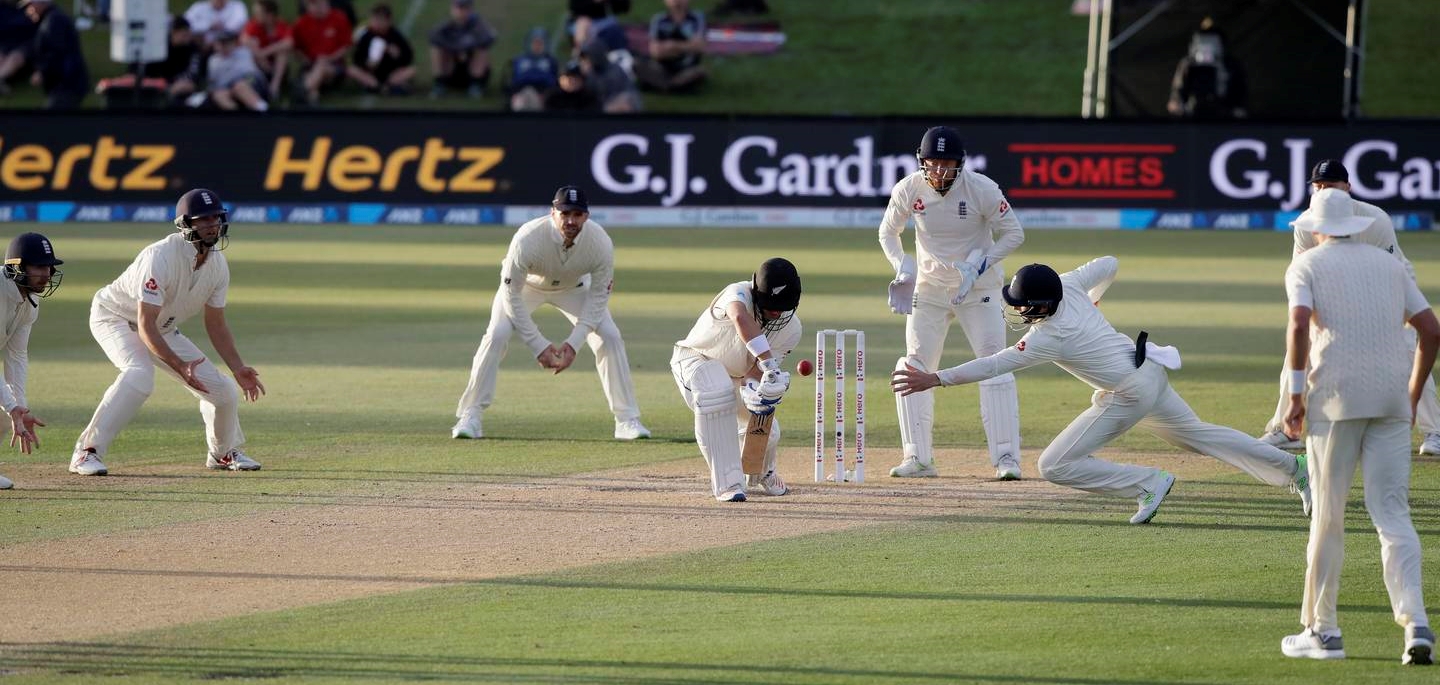Test Match Therapy: The Greatest Escapes 5
0England at Christchurch, March 30-April 3, 2018
England 307 & 352/9
NZ 278 & 275/8
Match Drawn
One of the many great aspects about Test cricket is how the two innings format allows any side a second chance. And this Great Escape series has so far featured matches where New Zealand has rescued games essentially by batting far better second time around.
This titanic tussle in Christchurch, however, managed to ramp up the fan torture to a whole new level by insisting that New Zealand rescue this Test not just once, but twice. In both innings. And in the hardest possible fashion: granite-like occupation of the crease fought constantly against a backdrop of too many in the wicket column. As a result it seemed to go on forever, even transcending the sporting seasons by beginning in Summer and ending in Winter. It was one of those timeless Test matches that leaves you struggling at the finish to recall just which part of your life the first day had slotted into.
It was made even more intense by what was at stake here: A series victory over England; the first in this country for 34 years, along with redemption for the misery of all those dropped catches at Eden Park that had cost us the last home series against England back in 2013. And, bizarre as this sounds, my personal anxiety levels were heightened by going into this final game 1-0 up after that astonishing Pink Ball Test win in Auckland a week earlier. There is simply too much to lose when you have everything to lose.
I was therefore hoping to see the Port Hills shrouded in rain when I switched on my television set on the morning of Good Friday 2018. No such luck. It was fine. Second choice then became a sunny five day run-feast where both sides eventually shook hands early and walked off as I cracked open a bottle of champagne. That was the kind of relaxing Easter break I was hoping for.
I ended up getting neither. Just one exceptionally long weekend of unwanted angst.
England’s first innings of 307 was an immediate concern. It was a dangerous middle-of-the-road total on this Hagley Oval pitch: too big for New Zealand to build any match-winning ascendency but big enough for England to gain a match-winning lead. Our best hope appeared to be trying to get as close as possible to 300 and taking the contest into a second innings shoot-out. What we simply could not afford to do, however, was to bat poorly, hand England a useful first innings lead with so much time left and surrender another series.
God, I hate Test cricket; I cursed loudly to myself as I searched through my cluttered shed looking for the waterblaster. Kane Williamson’s presence at the crease had kept me in front of the television at 17 for 4. But his demise proved too much.
B J Watling was still there. That was good. But at 36 for 5 just about the last person you desire to appear at the crease is Colin de Grandhomme. And Tim Southee was in next. These two are the kind of batsmen who ordinarily encourage a lot of warming up in the outfield by bowlers who realise they will not even have to bother with a set-up routine. One ball is often sufficient. And it does not have to be a good one either.
What then unfolded was surreal. Big Colin initially got his bearings by dining out on some short-pitched stuff from Mark Wood, before then settling in for what became a sensible, thoughtful and measured test innings. Told you it was surreal. Watling, meanwhile, was just Watling: smart decision-making and clever accumulation. The two of them together reminded me of Morecambe and Wise, a combination so disparate in both stature and method that it should never work, yet able to successfully work by cleverly complimenting each other’s obvious differences.
They broke the New Zealand sixth-wicket record against England by adding 142 before Tim Southee came out and boldly knocked up 50 off 48 balls. To cap it off Neil Wagner and Trent Boult then added 39 for the last wicket and New Zealand was right back in the game.
I decided that the scientific explanation for New Zealand’s recovery was clearly my decision to start waterblasting. And it therefore left me with no option but to carry on waterblasting for the remainder of the match.
Seldom is waterblasting fun but it is when the Black Caps are fighting back and you have a radio commentary team of Waddle, McHardy and Agnew for company. And Graeme Swann doing comments. Swann was a cricketer who attacked everything he did on the field with menace. He was an Australian born in a Northamptonshire body. But who would have thought he could be so entertaining in a commentary box? His exquisite impersonations of Geoffrey Boycott and Kevin Pietersen were waterblasting gold.
New Zealand’s inability to strike early in England’s second innings meant this Test match now entered what I call the Phoney War Phase; when the sole purpose of the third innings becomes when the declaration is made and the real battle can finally kick-off. That finally happened when Joe Root called time before tea on the fourth day, leaving New Zealand 382 to win and me with 132 overs to survive.
Daylight Saving had fortuitously ended that weekend and bad light stopped play with New Zealand looking relatively comfortable at 42 without loss. This solid start and a now seemingly docile pitch left me confident enough to finally pack up the waterblaster and head back to work on Tuesday.
When at work it is easy to lose concentration and forget about the start time in the cricket. I switched on a TV a few minutes late to discover that New Zealand had progressed from its overnight score of 42 without loss to 42 for 2. I suffered an instant attack of queasiness, then broke out in a clammy sweat when realising my slightly late arrival also meant I had missed the entire innings of cornerstone Kane.
I now had two options. The first was to leave a note for my work colleagues explaining that I suddenly had to return home to finish off some waterblasting. The second was to endure one of those insufferably long days at work blighted by excruciatingly tense Test match cricket being played somewhere hundreds of kilometres away. I opted for the second in the futile hope that I could simply ignore it. But it becomes somewhat farcical when the biggest cricket fan in the office starts snapping at other people and insisting they switch the TV off and actually do some work.
Of course we can all laugh about it now. Except if you are English. They probably felt like their eleven cricketers under the captaincy of Joe Root at Hagley Oval, who spent most of the day letting out yelps of anguish, clutching their heads in their hands, and kicking despairingly at the ground, as Black Cap batsman after Black Cap batsman arrived and established base camp amidst a tightly-circled crowd of expectant fielders.
It is hard to pick out any one individual. Such defiance is seldom displayed by so many. Tom Latham held together the top half of the innings (83 in just under five hours) but the three ‘all-rounders’ lower down the batting card were the true heroes of Hagley: Colin de Grandhomme (45 off 97 balls), Ish Sodhi (56 unbeaten off 168), and Neil Wagner with an astonishingly belligerent 107-minute seven.
I reckon Wagner is the most competitive person born since Genghis Khan. I base this evaluation not only on his ability to bowl with the same energy and commitment at 6pm as he does at 11am, to bowl all day if he was asked to, to bowl most of the day with two broken toes, or those earth-shattering orgasmic screams and crouched fist-pumps every time he takes a wicket, but also by once observing him play 20 minutes of ‘friendly’ football with his Otago teammates at the Basin Reserve. I bet nobody in the Black Caps is stupid enough to ask him for a game of darts.
I thought he was going to cry when he was finally out at Hagley, such was his profound disappointment at not seeing the job through to the finish. But the job was done, thanks Neil, and the game was called-off shortly afterwards amidst the fading autumnal light of Christchurch, with New Zealand eight wickets down and Joe Root reluctant to leave.
At last. I had waited more than five years to wipe away the frustration and agony of when the tables were turned and Kane Williamson had bowled a last over at Monty Panesar in fading light at Eden Park. People scattered everywhere in scenes bordering on pantomime, but Panesar survived and a first Series victory against England at home in three decades was gone. But now our national pride had been restored. By a player born in Zimbabwe, a player born in India, and two players born in South Africa.
Follow Euan on Twitter

